I am not a surfer, yet I went to Siargao1 in January 2019. One thing I recommend for non-surfers like me, is to avail of island-hopping tours. One of them is a Three-Island tour, going to three nearby islands of the municipality2 of General Luna3 – Guyam, Daku and Naked Islands. Allow Tita S to tell you about it.
You can visit these islands as part of a group package tour, or a private tour. Just google service providers.
The Three Island Hopping tour package is inclusive of: boat transfers (for a group of 6-10 people), life vests, snorkel gear, barbecue lunch with drinks, and guide, as well as entrance, docking and tourism fees. Some may include pick-up at your resort and back.
You can also book online via Klook, or avail of cheaper tours offered by other local tour operators in the island. Rates range from PHP800 to PHP2,000 per person, just clarify inclusions.
Another option is to have a private tour for a group. A private boat tour allows for flexibility of your stay per destination. If you opt for a private tour, negotiate inclusions, depending on the price quotation. You can bring your own food, or have food cooked at Daku Island, the usual island for lunch in this kind of tour. Fees for entrance, docking, tourism, and cottage rentals (for lunch) are usually not included.
Let me give you some suggestions on what to bring for this day tour to maximize your enjoyment:
- Sunblock – apply beforehand and reapply as needed
- Swimwear – wear this already, under your clothes or wrap, so it would be easy for you to dive and do other water activities
- Fully-charged cellphones, cameras, GoPro or similar gadgets, drones, extra batteries and chargers
- Refillable water bottle – Kermit, our tour operator, provides water and it is best to bring your own water bottle; just ask for it to be refilled as needed. However, I prefer to bring my own water, so I bring my own water too in my dry pack.
- Personal medicine/s
- Snacks – It might take some time before your lunch can be prepared and grilled so it would be best to bring something to munch on while waiting, especially for those who easily get hungry.
- Extra clothes, towel, basic toiletries – if you will dive, swim, or snorkel
- A hat or cap – to wear during your boat ride, strolls around island/s, or any above-water activity
- Cash – for that fresh coconut, drink, snack, or whatever else you might want to buy
- Snorkeling gear – if you have one; you can also borrow snorkels from Kermit but you need to pay a PHP500 safety deposit which will be returned to you once you return the gear in good condition, upon your return.
- Dry pack bag – to keep all your gadgets and belongings safe and waterproof.
- Leave nothing but footprints! Take nothing but memories and pictures/videos!
THREE ISLAND OVERVIEW
The three islands included in this tour are near the shores of General Luna3, Siargao1, so they are very accessible and can easily be reached by boat. All these islands are located south-southeast of the municipality2 of General Luna, in the island-province4 of Siargao, in the province of Surigao del Norte5, in the Caraga6 Region7 of Mindanao8, Philippines. Each island is unique so let Tita S briefly tell you about them:
Guyam Island is a small, tear-drop shaped, privately-owned island, located around 2 km (1.2 mi) from General Luna2, according to the Wikipedia page “Guyam Island”.9
It has a small and narrow white sand beach with coral rock formations. It is the smallest island among the three islands included in this day tour and it takes about three minutes from one end to another.
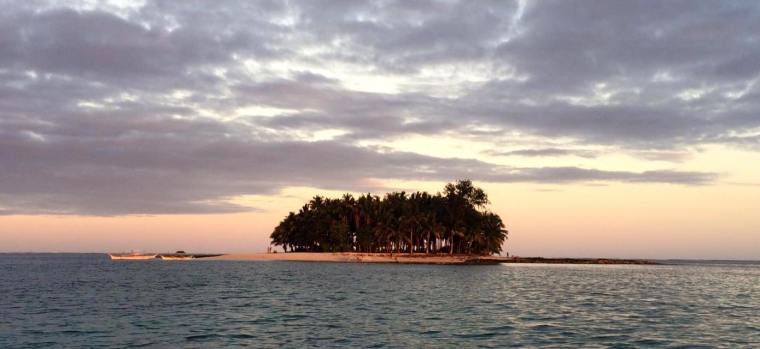 Guyam Island, Siargao – Source: https://www.facebook.com/pg/kermitsiargao/photos/?ref=page_internal
Guyam Island, Siargao – Source: https://www.facebook.com/pg/kermitsiargao/photos/?ref=page_internal
It is full of coconut trees. There are a couple of vendors who sell snacks and drinks so be ready with your cash. I was told you can order a fresh coconut, locally called buko, for PHP50.
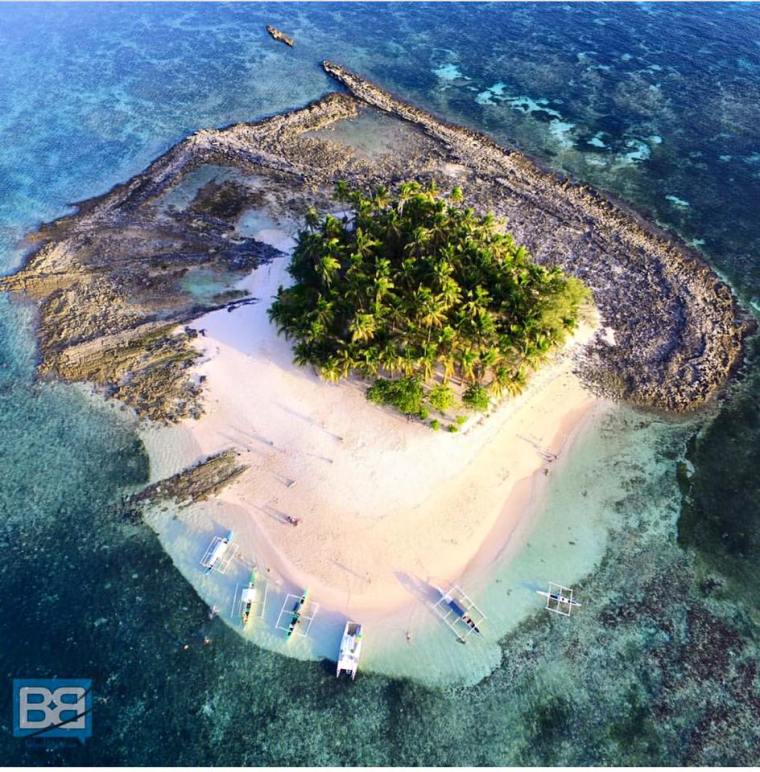 Guyam Island, Siargao – Source: https://www.facebook.com/pg/kermitsiargao/photos/?ref=page_internal
Guyam Island, Siargao – Source: https://www.facebook.com/pg/kermitsiargao/photos/?ref=page_internal
You can also snorkel, and even go fishing, from this island. There is a reef which surrounds the island. Just inquire from your guide and, again, be ready with your cash.
There are cottages for rent, and the island promises a great sunset for nature-loving tourists who are willing to stay overnight!
Daku Island is the biggest island among the three, located between the two other islands.
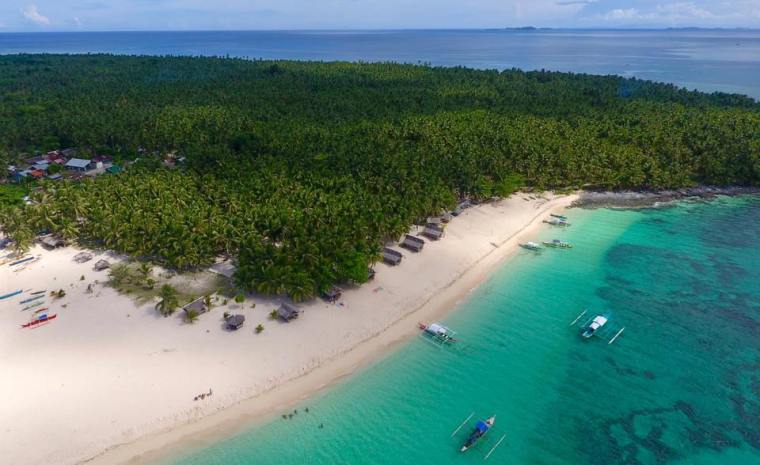 Daku Island, Siargao – Source: https://www.facebook.com/pg/kermitsiargao/photos/?ref=page_internal
Daku Island, Siargao – Source: https://www.facebook.com/pg/kermitsiargao/photos/?ref=page_internal
Very aptly named since the word “dako” in Cebuano10 means “big”. It is the usual island where lunch is served due to its size, compared to the two other islands.
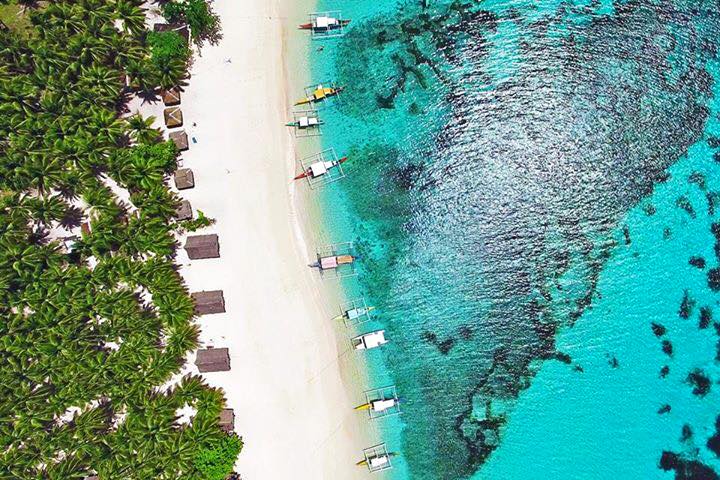
Daku Island, Siargao – Source: https://www.facebook.com/pg/kermitsiargao/photos/?ref=page_internal
It has a small fishing community and some locals can cook and prepare lunch for you and your private group, for a fee.
There are more than enough coconut trees everywhere on the island for shade, plus there are native picnic huts or cottages located all around, of course, for a fee, if the rental is not included in your tour.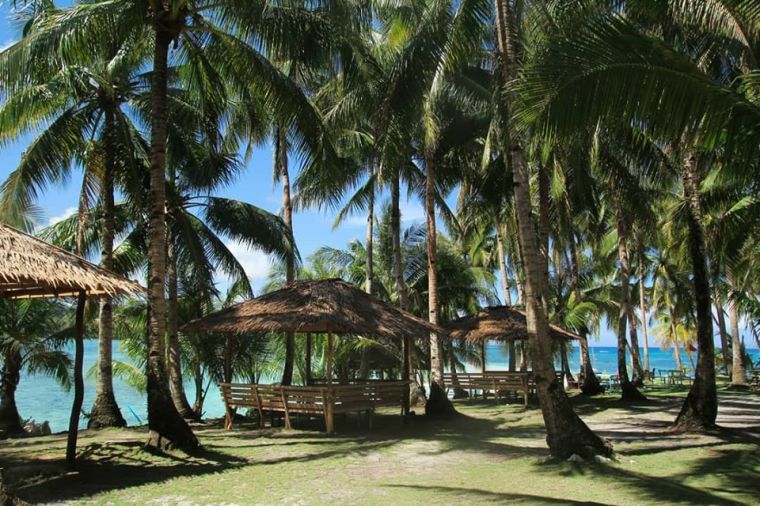 Daku Island, Siargao – Source: https://www.facebook.com/pg/kermitsiargao/photos/?ref=page_internal
Daku Island, Siargao – Source: https://www.facebook.com/pg/kermitsiargao/photos/?ref=page_internal
Ask your tour guide for the rental of paddle boards and kayaks for water sports in this island. Of course, you can also swim, and sunbathe for a more pronounced tan line. It is also good to walk around with your companions and take all the photos and videos you want.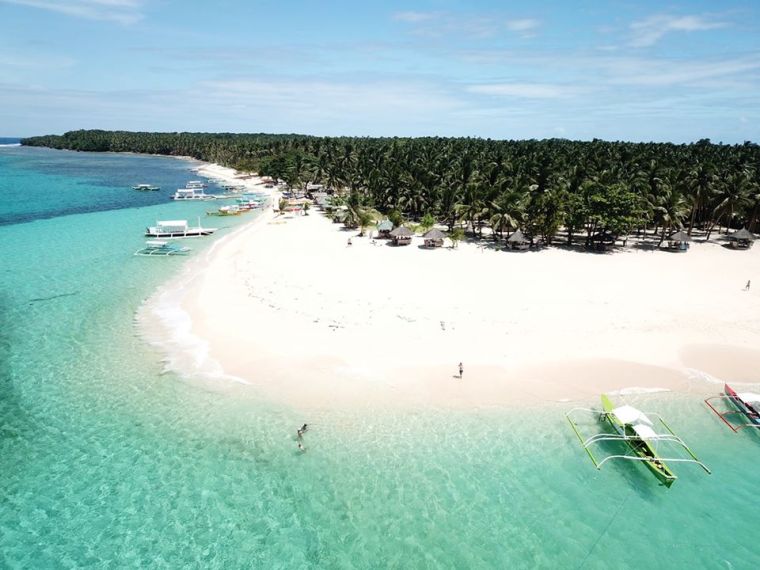 Daku Island, Siargao – Source: https://www.facebook.com/pg/kermitsiargao/photos/?ref=page_internal
Daku Island, Siargao – Source: https://www.facebook.com/pg/kermitsiargao/photos/?ref=page_internal
For a private tour without provision for lunch, here are your options: bring your own cooked lunch, negotiate lunch in this island, or go to the public market in General Luna2 for the freshest catch of the day: seafood and fishes. Fruits and vegetables, on the other hand, may not be that fresh since they come from other towns. You may then have the locals in this island to cook for you, for a fee. Order, or have your food cooked, upon arrival since it could take an hour for grilled items to be cooked.
A picnic cottage can be rented, or for the budget-conscious, bring a large picnic blanket for your group to enjoy your grilled seafood feast. It can get crowded at lunch during peak season so it would be best to ask your guide for your designated cottage. For private tours, spot a vacant cottage and pay its rental fee, or locate a tree and claim it as yours for shade and lunch during your stay on this island.
Naked Island
Naked Island is also called Pansukian Island. Now, now, dearest Seniors, the name does not mean that this island has a nude beach! It is called Naked Island because there are no trees nor shade on the island.
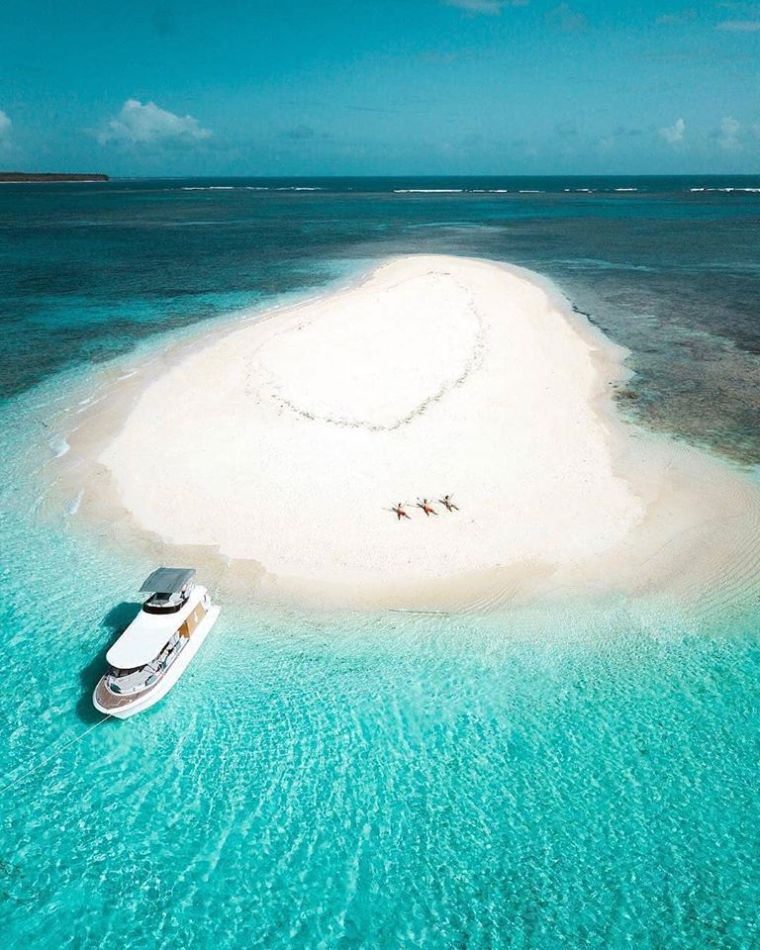 Naked Island, Siargao – Source: https://www.facebook.com/pg/kermitsiargao/photos/?ref=page_internal
Naked Island, Siargao – Source: https://www.facebook.com/pg/kermitsiargao/photos/?ref=page_internal
This island is shaped by the changing tide. It is like a sandbar, around 200 meters long, with powdery white sand all around. That is it, naked indeed! It takes about five minutes to walk from one end to another. They say that sunsets are great here too!
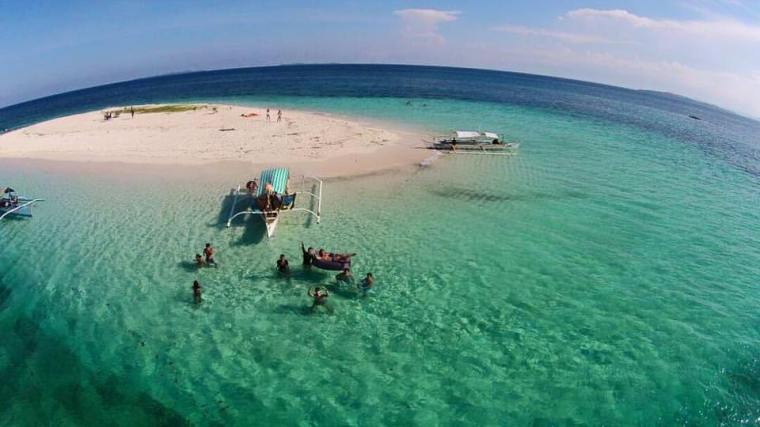 Naked Island, Siargao – Source: https://www.facebook.com/pg/kermitsiargao/photos/?ref=page_internal
Naked Island, Siargao – Source: https://www.facebook.com/pg/kermitsiargao/photos/?ref=page_internal
You can swim in the surrounding cool, crystal-clear waters, sunbathe, sit and finish getting your tan in this last stop of your tour. Of course, do not forget to take 360° videos and endless photos of the sand, sea and sky, without any obstruction on this naked island!
SIARGAO’S THREE ISLAND HOPPING DAY TOUR PACKAGE AND MY EXPERIENCE
And now, let me share with you our three-island hopping tour of Siargao1:
My group opted to avail of the tour package of Kermit Siargao11, in the municipality2 of General Luna3 where we also stayed.
We joined a group tour costing PHP1,000 (about US$20) per person. I feel that this package price is reasonable.
Full payment, in cash or through credit card, must be made a day before the tour date, to guarantee a slot. A minimum of 6 persons is required, or the tour will be cancelled. There are no refunds once payment has been made, unless weather does not permit the tour. So, leave a contact number for possible cancellations. You can join the next tour but if you decide to cancel, only 50% will be refunded. Visit https://www.kermitsiargao.com/island-hopping
It was a day tour, with only three nearby destinations: Guyam, Daku and Naked Islands, in that order. We were able to return to General Luna3 at around 4:30 pm.
The tour package was inclusive of boat transfers (for a group of 6-10 people), life vests, snorkel gear, barbecue lunch with drinks, and guide, as well as the entrance, docking and tourism fees.
There were four adults and a 7-year-old kid in my group, and we joined other local and foreign tourists for a group package tour. We rode a tricycle from our resort to Kermit11. No worries, drivers know where it is located.
We had an early breakfast at Kermit11 at around 7AM and we finished just in time to join the tour group.
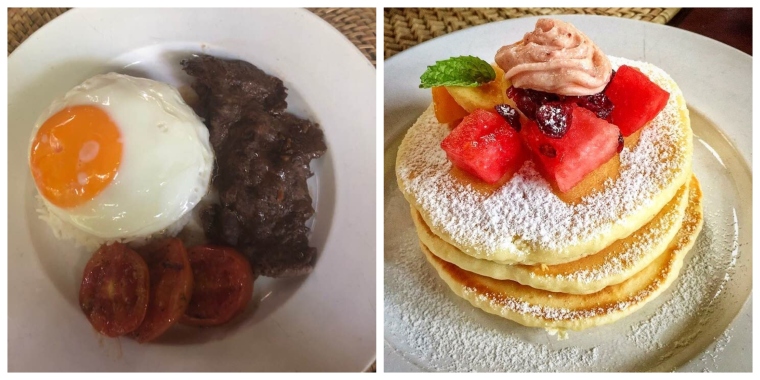 All adults ordered the Filipino Breakfast – Tapa (fried, marinated beef), rice, and fried egg. Our grandchild ordered Kermit Pancakes – three stacks of pancakes with fruits in season, butter and maple syrup. I took the picture on the left and I got the picture on the right from the Facebook account of Kermit – https://www.facebook.com/kermitsiargao/photos/a.285014781583559/2303664813051869/?type=3&theater
All adults ordered the Filipino Breakfast – Tapa (fried, marinated beef), rice, and fried egg. Our grandchild ordered Kermit Pancakes – three stacks of pancakes with fruits in season, butter and maple syrup. I took the picture on the left and I got the picture on the right from the Facebook account of Kermit – https://www.facebook.com/kermitsiargao/photos/a.285014781583559/2303664813051869/?type=3&theater
We left Kermit11 around 9AM and rode a tricycle to the small pier. 
We then sailed off to our first island destination – Guyam Island, around 20 minutes from General Luna3.
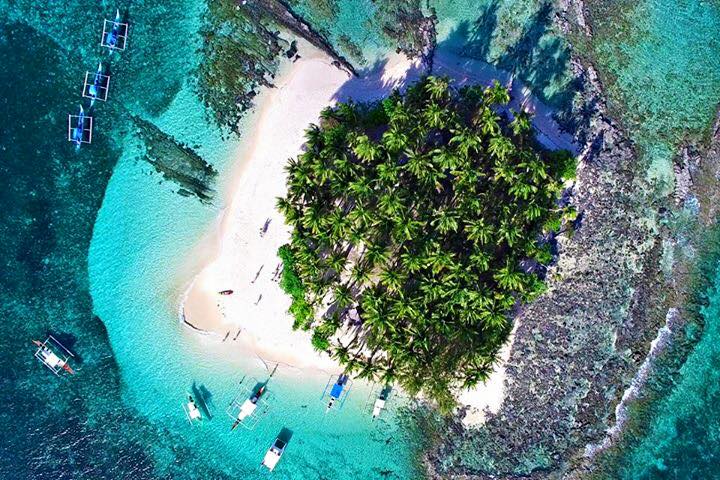
Aerial view, Guyam Island, Siargao, https://www.facebook.com/pg/kermitsiargao/photos/?ref=page_internal
Some tours start with Naked Island and end with Guyam Island. I think the guides know how busy the day is, and perhaps agree to switch start and end points so as not to overcrowd the islands, for the maximum enjoyment of all tourists for that day.

For sure, our tan lines started at Guyam Island! We walked around coconut trees and along the beach, taking videos and photos. Other members of the group opted to swim and enjoy the cool, clear water.
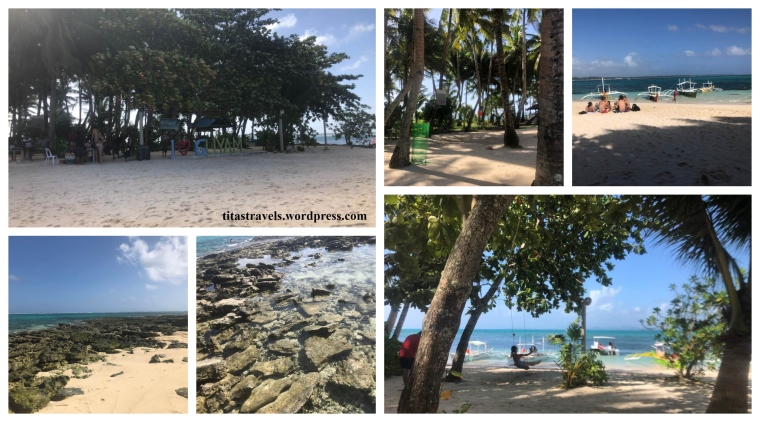 Guyam Island, Siargao, January 2019
Guyam Island, Siargao, January 2019
A popular spot to have a solo or group picture is a place with “I (symbol of a heart) Guyam Island”.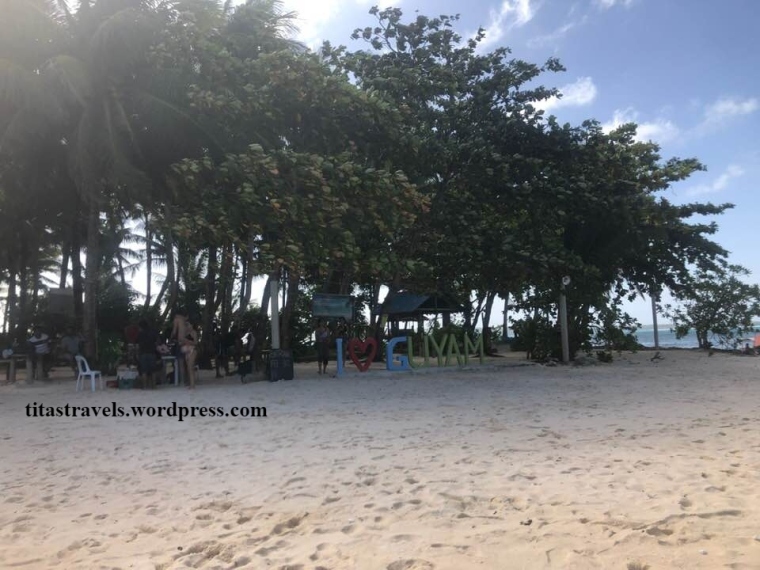
There are swings for more pictures and just for chilling under the coconut trees. Some tourists bought snacks and cold drinks from the vendors in the island.
Before noon, we headed to the biggest island among the three islands for that day – Daku Island.
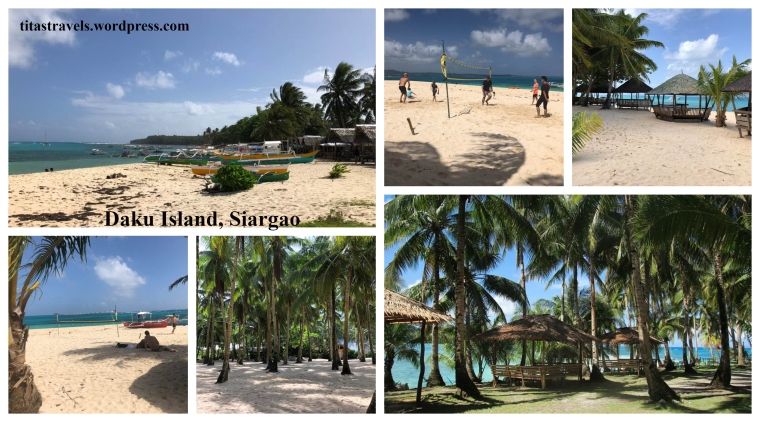 All the pictures in the collage are my January 2019 pictures, except for the bottom-right which I got from https://www.facebook.com/pg/kermitsiargao/photos/?ref=page_internal
All the pictures in the collage are my January 2019 pictures, except for the bottom-right which I got from https://www.facebook.com/pg/kermitsiargao/photos/?ref=page_internal
We patiently waited for our barbecue lunch by exploring the island and its beach, and taking so many photos and videos. Other tourists in our group decided to have a swim and/or sunbathe. Some played beach volleyball.
Our banquet-style grilled lunch was served past noon. It consisted of freshly grilled fish and pork chops, halabos12 na hipon, fish ceviche, skewered vegetables, pancit bihon13, pickled cucumber (with tomato slices and onions), and ensaladang talong14, and newly boiled rice. Fresh watermelon, mangoes, pineapple slices and bananas were our desserts.

The dipping sauce for the grilled pork and fish was delightful, made of soy sauce, vinegar, chili slices and seasonings. We enjoyed the varied textures and flavors of all the viands, and appreciated the fresh fruits. Being so hungry, we finished the entire grilled feast!
There are some tour providers who offer a boodle fight lunch15. This picture shows the famous Spider Shell16 which is available in this island. Perhaps, next time, I will try it.
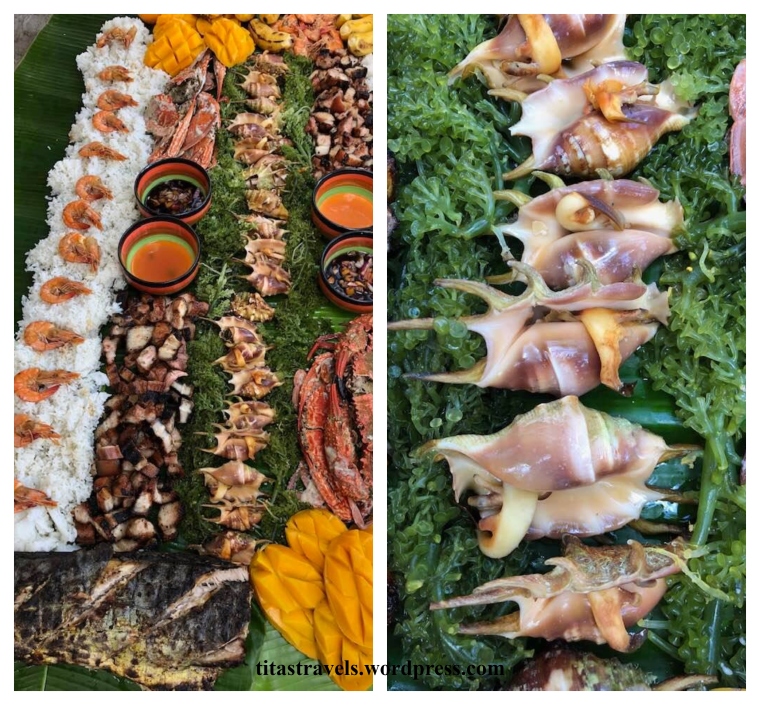 Boodle Fight offers by another tour provider at Daku Island, Siargao. featuring Spider Shell, locally called Saang. Foreigners, know more about boodle fight, read my post Foreign Seniors Ask: WHAT IS BOODLE FIGHT?
Boodle Fight offers by another tour provider at Daku Island, Siargao. featuring Spider Shell, locally called Saang. Foreigners, know more about boodle fight, read my post Foreign Seniors Ask: WHAT IS BOODLE FIGHT?
After lunch, we tried the inviting clear water and took more pictures. We left before 3PM for our third, and last, destination, Naked Island. It was a short boat ride, about 20 minutes. Actually, you can see a small patch of grass at the center of this island.
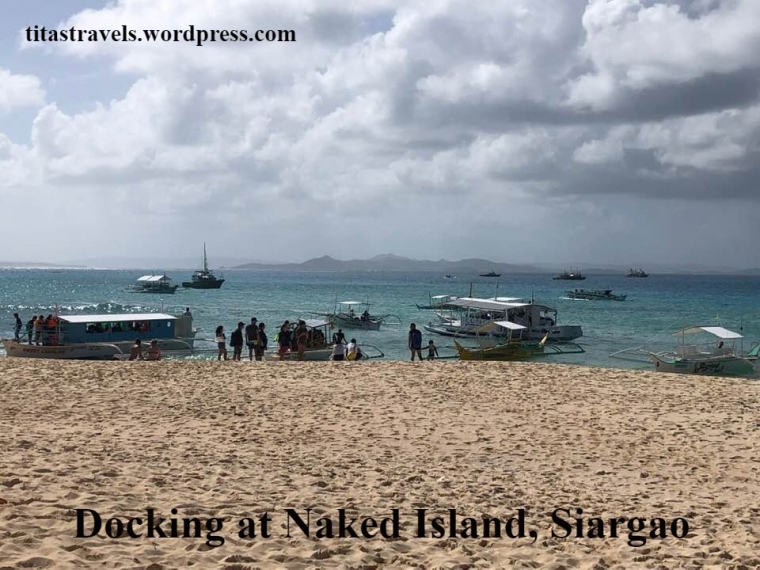
The hat we brought came in handy since there was no shade at all! We enjoyed the barren yet tranquil vibe of this island, and took photos and videos. Others swam, while foreigners took their last chance to get a tan.
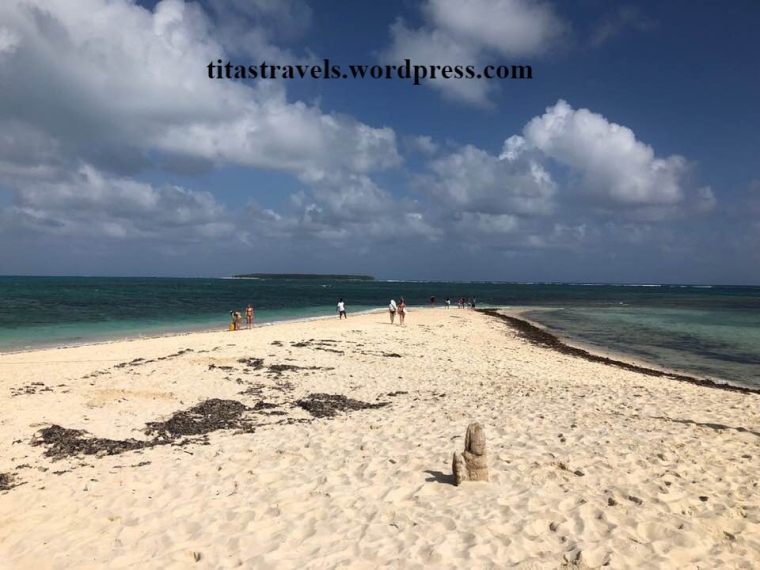
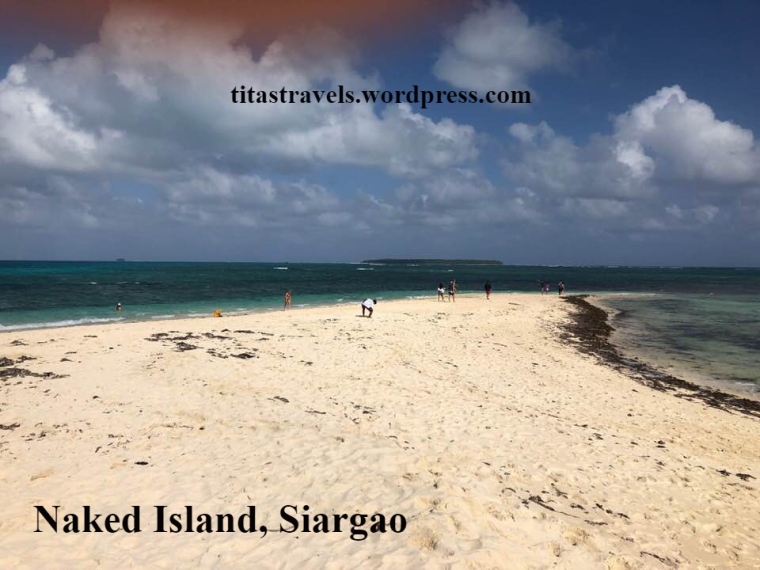
We left Naked Island around 4PM and we were back in Kermit11 at about 4:30 PM, in time for Happy Hour!
Bottomline, the Three Island Hopping Tour of Siargao1 is reasonably priced and would be appreciated by nature lovers and adventure seekers. Beach bumming and island vibe to the max! What more can you ask – sky above, sand below, sea beyond, and peace within!
This is not a sponsored post. We paid for our tour.
Read more about Siargao in related posts: MAGPUPUNGKO BEACH, TIDAL POOLS AND ROCK FORMATIONS (Pilar, Siargao, Surigao del Norte, Philippines), SUGBA LAGOON-KAWHAGAN ISLAND TOUR (Siargao, Surigao del Norte, Philippines), A HEALTHY ALTERNATIVE AT SHAKA (Siargao, Surigao del Norte, Philippines), A BREATHTAKING VIEW AT SIARGAO’S CLOUD 9 BOARDWALK AND SURFING VIEWING DECK, FOR NATURE LOVERS, DO NOT MISS PALM VIEWPOINT SIARGAO, CEV: Ceviche Heaven in Siargao, NOW YOU KNOW: CLOUD 9 SIARGAO and Seniors, Now You Know: S.E.A. MOVEMENT – FIGHTING TO PRESERVE SIARGAO!
Source of photos used in cover photo-collage: https://www.facebook.com/pg/kermitsiargao/photos/?ref=page_internal
Did you find this post informative? I would like to hear your comment/s regarding the Three Island Hopping Tour of Siargao1.
See other interesting places through other posts in this category and other categories of SCapades, Pinoy Delights, and Smart Travelers – Foreign Travelers Ask, Now You Know, and Say, Say, Say. Happy reading, and I hope that you will appreciate what I shared and some of the featured destinations will be part of your future travel plans!
Do share this post with your Facebook friends, follow me by clicking on the bottom right corner of your device, and do not forget to like this post. Thank you.
– – – – – – – – – – – – – – – – – – – – – – – – – –
The following terms are defined for interested readers, especially those with “Senior-Moments”, not familiar with Filipino terms, and those too busy or lazy to Google such terms:
1Siargao is a tear-drop shaped island in the Philippine Sea, almost 200 km southeast of Tacloban, in the province4 of Surigao del Norte5, in the Caraga6 Region7 of Mindanao8, in the Philippines. It has a land area of about 437 sq. km. (169 sq.mi.). It has one of the largest mangrove forest reserves in Mindanao, particularly in the municipality2 of Del Carmen17, covering 4,871 hectares.
It has excellent surfing conditions, particularly during the southwest monsoon, locally called habagat, from August to November. Local and international surfers call its municipality2 of General Luna3 as the “The Surfing Capital of the Philippines”, with surfing pros enjoying the challenging waves in nearby Tuason Point area as well. Siargao was also named by Surfer as one of the “Ten Best Surf Trips of All Time” in 1995.
The information was obtained from the Wikipedia page “Siargao”18 and the Wikitravel page “Siargao”19.
2A municipality is small, single urban administrative division, or local government unit (LGU), in the Philippines which has corporate status and powers of self-government or jurisdiction as granted by law. It is a unit under a province4, subdivided into barangays20, and is called town, or bayan. In the Philippines, a municipality is headed by a mayor, a vice-mayor, and members of the Sangguniang Bayan (legislative branch). It can enact local policies and laws, enforce them, and govern its jurisdictions. It can enter into contracts and other transactions through its elected and appointed officials, and can tax as well. It enforces all local and national laws. The information was obtained from Wikipedia page “Municipalities of the Philippines.”21 See a related post: Foreign Seniors Ask: HOW MANY CITIES ARE THERE IN THE PHILIPPINES?
3General Luna is a fifth class municipality2 in the province4 of Surigao del Norte5, in the Caraga6 Region7 of Mindanao8, in the Philippines. It is the home of world-renowned Cloud 9 waves, so this town is called “The Surfing Capital of the Philippines”. It was formerly called Cabuntog, and currently has 19 barangays20, 15 of which are located on Siargao Island1, while 4 are on the other outer islands. The islands of Anahawan, Daku and La Januza are within its jurisdiction. The area is protected within the Siargao Islands Protected Landscapes and Seascapes (SIPLAS) under Republic Act 7586 (National Integrated Protected Area System Act) of 1992. The information was obtained from the Wikipedia page “General Luna, Surigao del Norte”22 and “Siargao”.18
4A province is the primary administrative and political division in the Philippines. It is the second-level administrative sub-division of a region7. There are 81 provinces (called “lalawigan”) in the Philippines. Each province is governed by an elected legislature called the Sangguniang Panlalawigan, and by an elected governor. In the Philippines, a province is divided into cities and municipalities2 (or towns), which in turn, are divided into barangays20, formerly called barrios. The information was obtained from Wikipedia page “Provinces of the Philippines.”23 See a related post: Foreign Seniors Ask: WHAT ARE PROVINCES IN THE PHILIPPINES?
5Surigao del Norte is a province4 in the Caraga6 Region7 of Mindanao8, in the Philippines. This province comprises two islands, Siargao1 and Bucas Grande, in the Philippine Sea, and a small area at the northeastern tip of Mindanao. This mainland portion borders Agusan del Norte and Surigao del Sur to the south. It is the second northernmost of the Mindanao provinces, and is an important transportation hub between Visayas (the central part) and Mindanao (the sourthern part of the country). It was founded on June 19, 1960. It has 20 municipalities2 and one component city, its capital, Surigao City. The information was obtained from Wikipedia page “Surigao del Norte.”24
6Region XIII, or the Caraga Region, is a Philippine region7 located in the island group of Mindanao8, with Butuan as its regional center. It has five provinces4: Agusan del Norte, Agusan del Sur, Dinagat Islands, Surigao del Norte5, and Surigao del Sur; 6 cities: Bayugan, Bislig, Butuan, Cabadbaran, Surigao and Tandag. The information was obtained from the Wikipedia page “Caraga.”25
7A region is an administrative division based on geographical, cultural and ethnological characteristics. Each region is further subdivided in provinces4, composed of cities and municipalities2 (or towns), which in turn, are divided into barangays20, according to the Wikipedia page “Regions of the Philippines”.26 See a related post: Foreign Seniors Ask: WHAT ARE THE REGIONS OF THE PHILIPPINES?
8Mindanao, commonly known as Southern Philippines, is one of the 3 major geographical divisions of the Philippines, located at the southernmost part of the country. It is the second largest island of the country and covers 6 administrative regions: Bangsamoro Autonomous Region in Muslim Mindanao (BARMM), CARAGA6 Region7, Davao Region, Northern Mindanao, Soccsksargen (South Cotabato, Cotabato, Sultan Kudarat, Sarangani and General Santos), and Zamboanga Peninsula. It is composed of 22 provinces4 and 33 cities. The information was obtained from the Wikipedia page “Mindanao.”27 The 2 other major geographical divisions of the Philippines are Luzon (in the northern part) and Visayas (in the central part of the country).
9“Guyam Island,” accessed May 13, 2019, https://en.wikipedia.org/wiki/Guyam_Island
10The Cebuano language, locally called Bisaya/Binisaya, is an Austronesian language spoken in the southern Philippines, originating from the island of Cebu, a province located in the Central Visayas region, in the Philippines. It is the most widely spoken of the Visayan languages. It is sometimes referred to as Cebuan, and spelled as Sebwano by the Komisyon ng Wikang Filipino, the official regulating body of Philippine languages. The information was obtained from the Wikipedia page “Cebuano language”.28
11Kermit Surf Resort and Restaurant is located at Purok29 5, in the municipality2 of General Luna3, Siargao Island1, in the province4 of Surigao del Norte5, in the Caraga6 Region7 of Mindanao8, in the Philippines. It offers accommodations, dining services, tour packages, and surfing and yoga lessons. Contact information: Cellphone numbers: Globe – +639176550548, Smart – +639209689934; Email: info@kermitsiargao.com; website: www.kermitsiargao.com
12Halabos is a Filipino cooking process consisting of fresh shrimp (locally called hipon), crab or other crustaceans cooked in water and salt. It is one of the easiest and most common way of preparing crustacean dishes in the Philippines. It is also spelled halbus, hablos or halbos. It is a verb meaning “to scald in saltwater” in Filipino.
Traditionally, it only requires boiling whole unshelled shrimp, crab, or other crustaceans in water and a little salt, for 1 – 3 minutes, until they turn reddish-pink. Nothing else is added, and the ingredients are allowed to stew in their own juices. Modern versions add spices (like chilis and garlic) and carbonated drinks like Sprite or 7Up, instead of water for a sweeter sauce. Butter may be added.
“Halabos na” is a Filipino prefix, so you can have halabos na hipon/sugpo (scalded shrimp/prawns), halabos na alimasag/alimango (scalded blue swimmer crab/mud crab, halabos na ulang (scalded lobster or giant river prawns), and halabos na curacha30 (scalded spanner crab).
The information was obtained from the Wikipedia page “Halabos”.31
13Pancit is the Filipino term for noodles, introduced by the Chinese, and adopted into the local cuisine, with many regional variations. Some versions of this noodle dish are stir-fried, often with sliced meat, shrimps and assorted/chopped vegetables. Pancit bihon is a type of pancit using very thin rice flour noodles, called bihon, with basically Chinese sausage and cabbage, as well as the same ingredients and manner of cooking, previously mentioned.
14Ensaladang talong is a Filipino salad (locally called ensalada) dish made of grilled, skinned and mashed eggplant (talong), mixed with white vinegar, chopped onions and tomatoes, seasoned with salt and pepper, sometimes topped with shrimp paste (bagoong). It is a favorite side dish or as an accompaniment to grilled or fried meat or fish.
15Boodle fight is the traditional military practice of eating a meal with the hands (locally called kamayan), without cutlery or dishes. The food is placed on top of a table lined with banana leaves, and diners stand shoulder to shoulder, in a line, on both sides of the table. It is common to have boiled rice at the middle, and viands (like dried or grilled meat, fish or seafood) equitably placed on the banana leaves.
Lunch and dinner boodle fights in island hopping tours may consist of charcoal-grilled meat (e.g., chicken or pork) and/or fish and grilled/fried fresh seafood (e.g., fish, shrimps, crabs and squid) with spicy soy sauce-vinegar dip, along with grilled vegetables (e.g., eggplant, okra, kangkong), salted eggs, and atchara32. Pancit13 can also be added as additional carbohydrate source. Other popular items can be added like lumpia33, fried fish, and fried chicken. Fresh fruits are usually served for dessert, such as sliced pineaples, mangoes and bananas.
The information was obtained from the Wikipedia page “Boodle fight”34.
16The spider shell, locally called saang, is a conch considered a delicacy in the Visayas (central part of the Philippines), and is also found in the Indian Ocean along Chagos, Madagascar and Tanzania, and in the Western Pacific. Its scientific name is Lambis scorpius. In the Philippines, it is usually grilled or boiled, and best enjoyed with a dip made of vinegar, chopped onions, garlic and chili pepper. The information was obtained from the Wikipedia page “Lambis scorpius”35 and https://www.aboutfilipinofood.com/saang/.
17Del Carmen is a fifth class municipality in Siargao Island1, in the province4 of Surigao del Norte5, in the Caraga6 Region7 of Mindanao8, in the Philippines. It is the home of Sayak Airport, the island’s main airport. This town was formerly called Numancia until 1966. It currently has 20 barangays20. The information was obtained from Wikipedia page “Del Carmen, Surigao del Norte.”36 Visit its website: www.visitdelcarmen.com
18“Siargao,” accessed October 13, 2019, https://en.wikipedia.org/wiki/Siargao
19“Siargao,” accessed October 13, 2019, https://wikitravel.org/en/Siargao
20A barangay is the smallest administrative division in the Philippines, headed by a barangay captain, aided by a Sangguniang Barangay (Barangay Council). It is the native Filipino term for a district or village. It was formerly called a barrio. In a metropolitan area, a barangay is an inner city neighborhood, a suburb, or a suburban neighborhood. The information was obtained from Wikipedia page “Barangay.”37
21“Municipalities of the Philippines,” accessed accessed May 13, 2019, https://en.wikipedia.org/wiki/Municipalities_of_the_Philippines
22“General Luna, Surigao del Norte,” accessed May 13, 2019, https://en.wikipedia.org/wiki/General_Luna,_Surigao_del_Norte
23“Provinces of the Philippines,” accessed July 17, 2018, https://en.wikipedia.org/wiki/Provinces_of_the_Philippines
24“Surigao del Norte,” accessed May 13, 2019, https://en.wikipedia.org/wiki/Surigao_del_Norte
25“Caraga,” accessed May 13, 2019, https://en.wikipedia.org/wiki/Caraga
26“Regions of the Philippines,” accessed July 17, 2018, https://en.wikipedia.org/wiki/Regions_of_the_Philippines
27“Mindanao,” accessed May 13, 2019, https://en.wikipedia.org/wiki/Mindanao
28“Cebuano language,” accessed May 13, 2019, https://en.wikipedia.org/wiki/Cebuano_language
29A purok is a division, or a portion of a less densely populated neighborhood, within an urbanized barangay20, in the Philippines. It often serves as a unit for delivering services and administration within a barangay. It is typically composed of 20-50 households, depending on the particular geographical location and cluster of houses. Its counterpart in a rural barangay is called a sitio. The information was obtained from Wikipedia page “Purok.”38
30Curacha is the local Chavacano name given to Ranina ranina, the binomial name of spanner crab, or red frog crab. It is commonly found in the waters of Zamboanga, Sulu and Bataan. It is usually steamed or boiled to preserve its delicate flavor. The information was obtained from Wikipedia page “Curacha.”39
31“Halabos,” accessed May 13, 2019, https://en.wikipedia.org/wiki/Halabos
32Achara, atchara, or atsara, is a pickled side dish, or accompaniment of fried or grilled foods, in the Philippines. It is made of grated unripe papaya, carrot and onion slices, julienned garlic, bell pepper strips, along with vinegar, syrup and salt. Raisins may be added.
33Lumpia is the Filipino term for “spring roll”. It is a savory dish made with a thin crepe pastry skin called “lumpia wrapper” enveloping a mixture of savory fillings, consisting of chopped vegetables (e.g., bamboo shoots, cabbage, carrot, green beans, leeks), or sometimes also minced meat (beef, chicken, pork and shrimp). It is often served as an appetizer or snack, and could be served deep fried or fresh (unfried). The information was obtained from the Wikipedia page “Lumpia”.40
34“Boodle fight,” accessed December 12, 2018, https://en.wikipedia.org/wiki/Boodle_fight
35“Lambis scorpius,” accessed December 12, 2018, https://en.wikipedia.org/wiki/Lambis_scorpius
36“Del Carmen, Surigao del Norte,” accessed May 13, 2019, https://en.wikipedia.org/wiki/Del_Carmen,_Surigao_del_Norte
37“Barangay,” accessed May 13, 2019, https://en.m.wikipedia.org/wiki/Barangay
38“Purok,” accessed May 13, 2019, https://en.wikipedia.org/wiki/Purok
39“Curacha,” accessed May 13, 2019, https://en.wikipedia.org/wiki/Curacha
40“Lumpia,” accessed December 12, 2018, https://en.m.wikipedia.org/wiki/Lumpia

